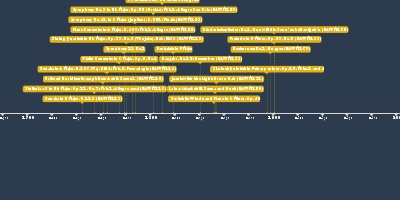jan 1, 1781 - String Quartet in Eb Major, Op. 33, No. 2 (The Joke), Hob. III:38 (NAWM 118)
Description:
Composer: Joseph HaydnGenre: String Quartet
Haydn wrote the six quartets of Op. 33 (also named the "Russian" quartets) for the public, rather than private patronage. He boasted that they were quartets of “a new and entirely special kind”. Some of these new elements that he introduced include naming the minuet movement "shcerzo" or marked "scherzando" (Italian for "joke"), and used rondo finales for quartet numbers 2, 3, and 4.
No. 2 earned its name ("The Joke") because of the playful and unexpected rests at the end of the finale.
Mvt. 1 (Allegro):
As typical of Haydn's quartets, this first movement is in sonata form. The structure is an expansion of binary form shaped by harmony and phrasing (rather than themes). Both halves are repeated, and the rhythmic figure that opens the movement (2 sixteenth notes leading to an accented note on the next beat) is so pervasive that there is relatively little contrast of character between theme. Thus, the eighteenth century sonata-form model is generally a better fit for this movement.
Haydn's Developments:
One of Haydn’s favorite tricks was to go to the relative minor at the end of the development and try to trick the audience into thinking that the recapitulation had begun in the wrong key (it hasn’t, because it’s still a part of the development). In this movement, he attempts this by seeming to begin the return of the opening material in Eb major when it was initially in c minor.
Mvt. 2 (Minuet and Trio):
As with many of Haydn’s early quartets, the minuet and trio - rather than the adagio - was the second movement. Joking elements in this Scherzo:
-Large, awkward leaps at the beginning
-Surprising, suddenly soft, and dissonant two measure figure that interrupts the otherwise regular phrasing
-Juxtaposition of styles: loud chords suggesting a boisterous peasant’s dance juxtaposed to hints of the learned style in a point of imitation
Mvt. 3 (Adagio):
For quartets, this movement is always in a different, usually closely related, key (such as here with Bb major). It is mainly alternating between A and B themes in different keys and different instrument combinations. It suggests a conversational style since the instruments share importance more equally than in the first movement, where it’s mainly a first violin melody and everyone else accompanying.
Mvt. 4 (Rondo):
The final movement is usually the fastest, and this rondo form movement is indeed the fastest of the quartet. As in any good traditional rondo, the A theme reprise is recognizable enough that the audience can hear the form, but interesting enough that they don't get sick of it.
The joke:
The melody’s short phrases and staccato notes are reminiscent of an opera buffa (comic opera). Another comedic trait is the tendency of the melody to outrun the accompaniment, spilling over into the middle of the measure rather than stopping each phrase on the downbeat. Additionally, the entire end is very joking, as he messes with tempo, splits up the phrase with rest, etc. Finally, the unexpected rests at the very end seem to be poking fun at the rondo theme, the beat counting musicians, and the audience wondering when to clap.
Added to timeline:
Date:
jan 1, 1781
Now
~ 244 years ago
